Jmeter+ InfluxDB+Grafana安装配置
前置条件:
系统:windows
jmeter:5.1
InfluxDB安装
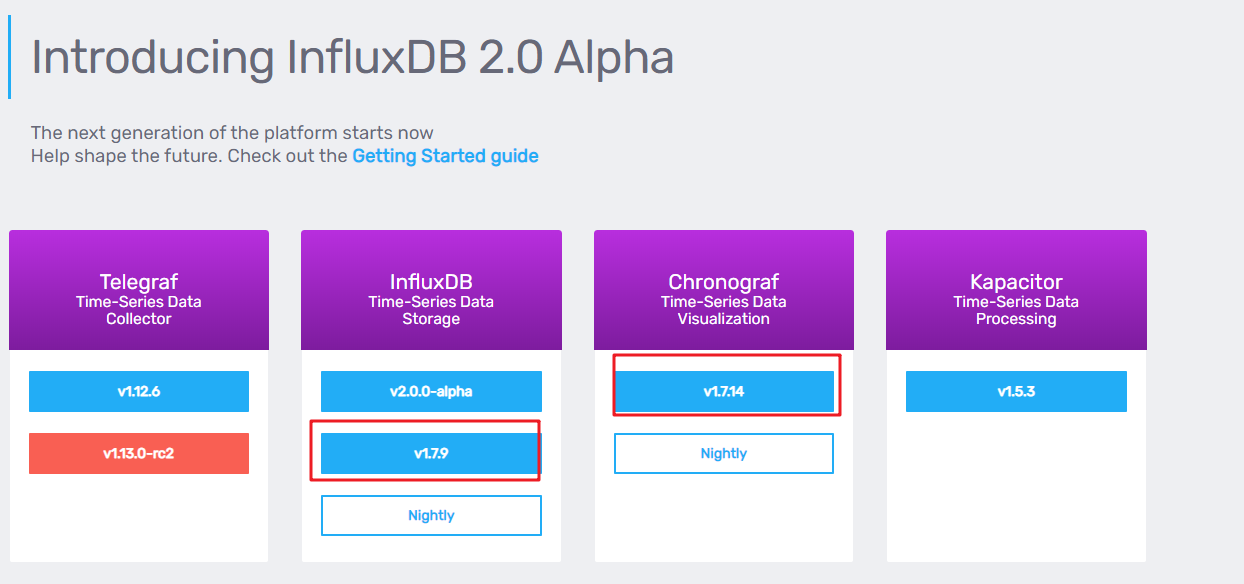
下载InfluxDB-v1.7.9和Chronograf-v1.7.14(InfluxDB的可视化web端)。
下载完成之后,解压到本地:如图
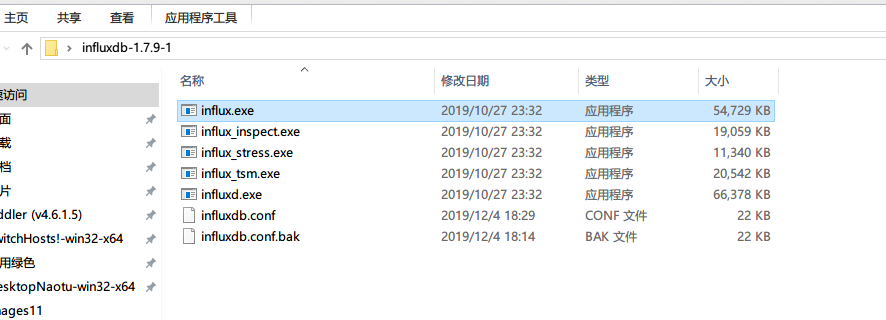
第一步:双击[influxd.exe],然后再双击[influx.exe]进入influx命令模式,使用show databases查看数据库信息,如图
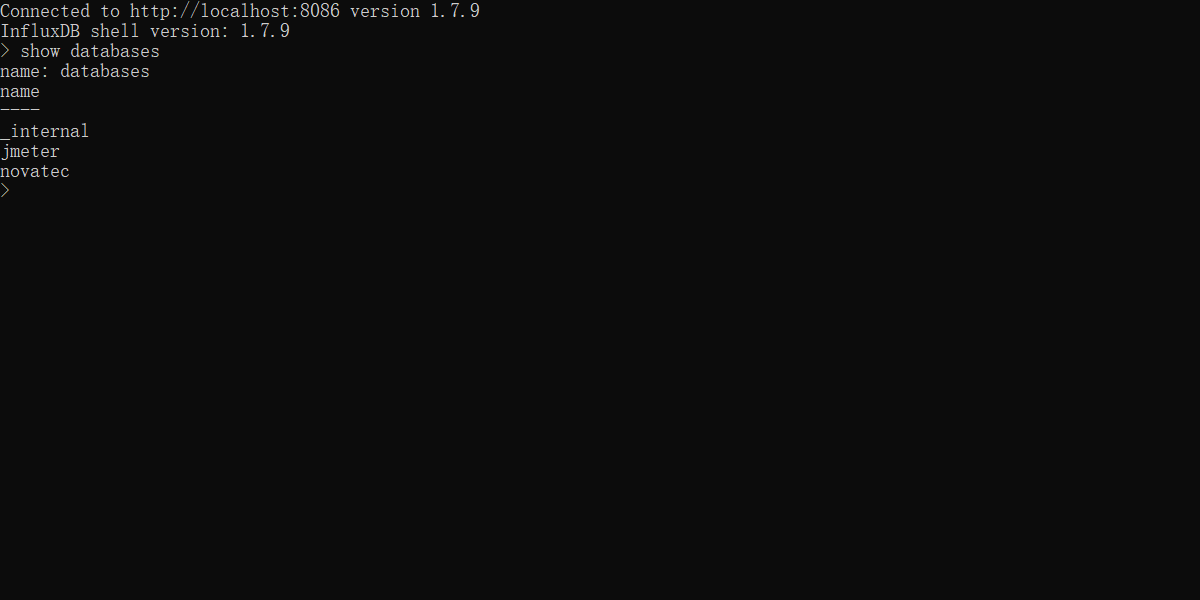
创建数据库:
CREATE DATABASE jmeter
CREATE DATABASE novatec
influxdb.conf修改的配置:
[[graphite]]
# Determines whether the graphite endpoint is enabled.
# enabled = false
# database = "graphite"
# retention-policy = ""
# bind-address = ":2003"
# protocol = "tcp"
# consistency-level = "one"
# 2019-12-04 修改graphite配置
enabled = true
database = "novatec"
bind-address = ":2003"
protocol = "tcp"
consistency-level = "one"
Chronograf安装
下载好Chronograf安装,这里省略...
然后打开浏览器输入http://localhost:8888/可以查看本地influx数据库
Grafana安装配置
下载Grafana官网https://grafana.com/grafana/download下载需要的版本,这里使用的是windows版本
安装完成之后,打开浏览器http://localhost:3000/,如图,确认端口号没有被占用,打开grafana仪表板。使用admin的登录名和密码,界面如图
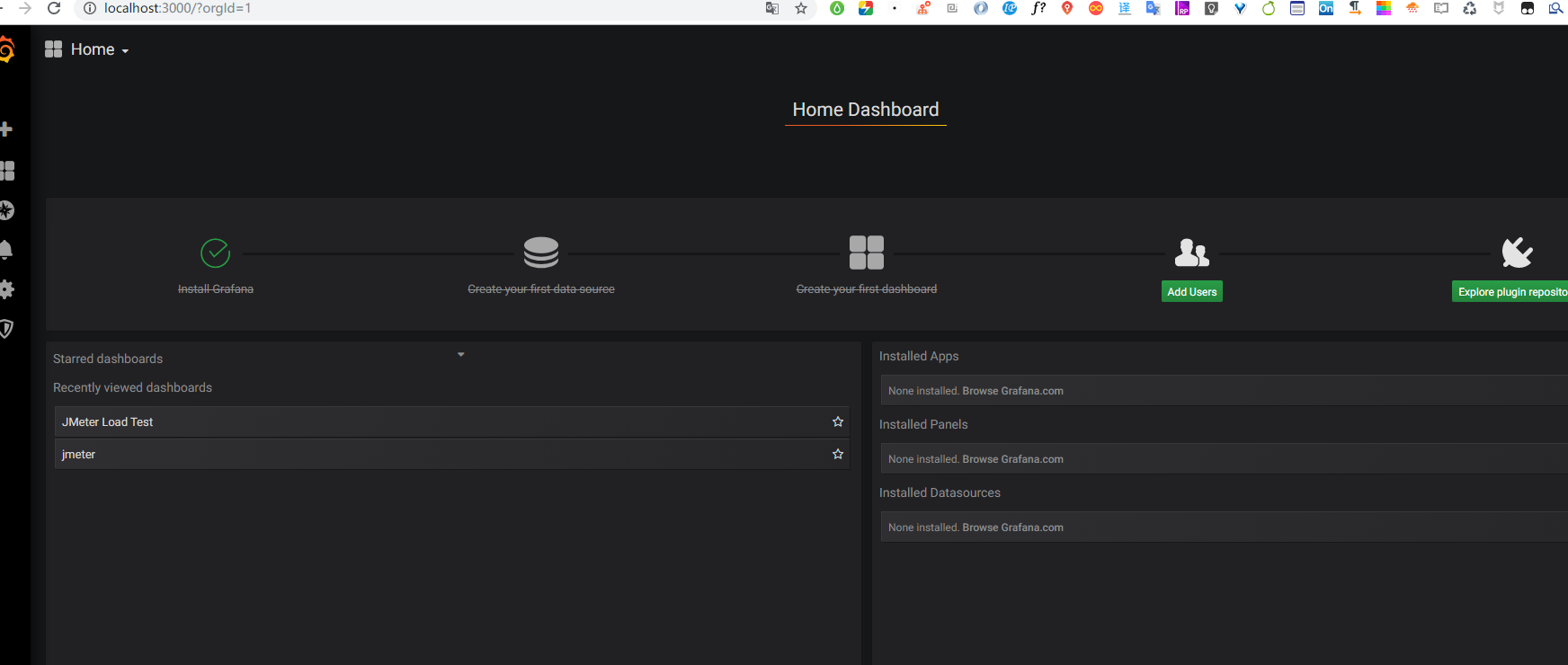
配置过程:
选择Add DataSource选项:
然后使用以下设置配置DataSource:
- 名称:Influxdb,任何名称都应该有用,
- 输入:InfluxDB,当我们连接到InfluxDB数据库时,
- 网址:
http://localhost:8086/, - 访问:,默认server,因为它直接连接到数据库,
- 数据库:novatec,以前创建的数据库。
- user:数据库的用户
- 密码:数据库的密码,这里为空
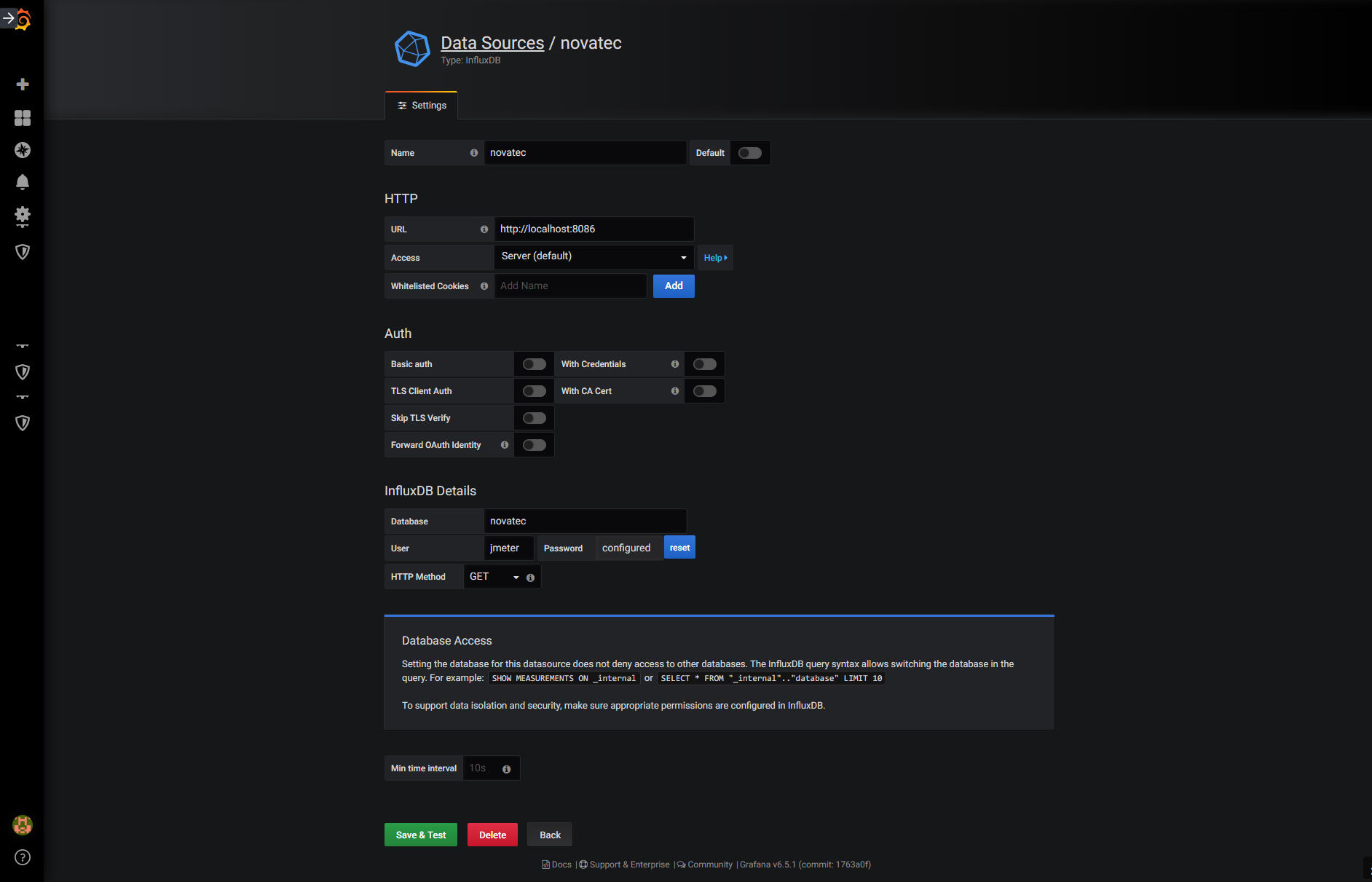
安装JMeter InfluxDB Writer
- 从JMeter InfluxDB Writer下载页面下载插件,
- 复制插件JMETER_HOME / lib / ext,
- 重启JMeter。
配置JMeter InfluxDB Writer
- 打开JMeter,然后打开示例JMX Script,
- 右键单击测试计划,然后选择Add> Listener> Backend Listener,
- 使用以下设置配置后端侦听器:
- testName:jpetstore,
- nodeName:测试节点,
- 流入数据库端口:8086,
- 潮流DBUser:jmeter,
- 流入数据库密码:无,
- InfluxDBDatabase:novatec。
让其他设置使用默认设置。如图
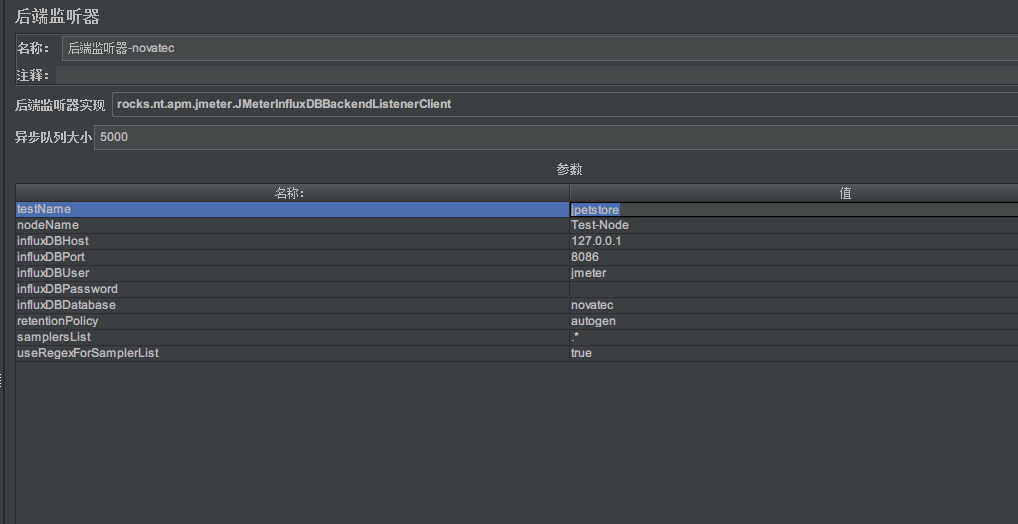
在Grafana创建新的Data-Source Novatec
- 创建映射到数据库的新数据源
novatec。
导入Novatec仪表板
请按照文档说明如何导入Grafana仪表板的详细信息。
- 打开Grafana,
- 选择导入新仪表板,
- 输入ID
1152,即Novatec仪表板的ID, - 选择指向
novatec数据库的数据源。
您应该能够在仪表板中看到动画图表。
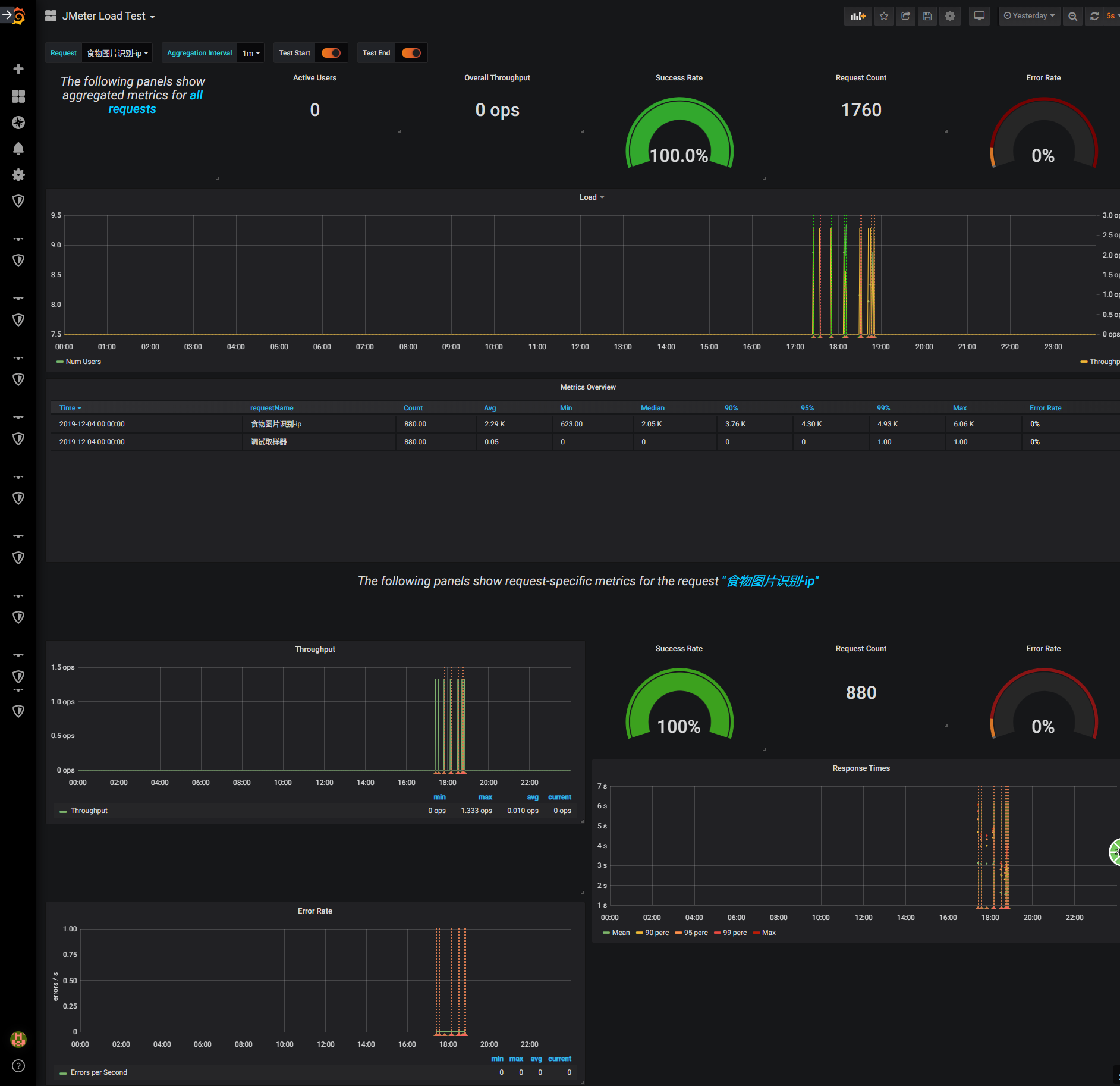
参考博客:JMETER结果分析
附件:Influxdb.conf配置文件
### Welcome to the InfluxDB configuration file.
# The values in this file override the default values used by the system if
# a config option is not specified. The commented out lines are the configuration
# field and the default value used. Uncommenting a line and changing the value
# will change the value used at runtime when the process is restarted.
# Once every 24 hours InfluxDB will report usage data to usage.influxdata.com
# The data includes a random ID, os, arch, version, the number of series and other
# usage data. No data from user databases is ever transmitted.
# Change this option to true to disable reporting.
# reporting-disabled = false
# Bind address to use for the RPC service for backup and restore.
# bind-address = "127.0.0.1:8088"
###
### [meta]
###
### Controls the parameters for the Raft consensus group that stores metadata
### about the InfluxDB cluster.
###
[meta]
# Where the metadata/raft database is stored
dir = "D:/influxdb/meta"
# Automatically create a default retention policy when creating a database.
# retention-autocreate = true
# If log messages are printed for the meta service
logging-enabled = true
###
### [data]
###
### Controls where the actual shard data for InfluxDB lives and how it is
### flushed from the WAL. "dir" may need to be changed to a suitable place
### for your system, but the WAL settings are an advanced configuration. The
### defaults should work for most systems.
###
[data]
# The directory where the TSM storage engine stores TSM files.
dir = "D:/influxdb/data"
# The directory where the TSM storage engine stores WAL files.
wal-dir = "D:/influxdb/wal"
# The amount of time that a write will wait before fsyncing. A duration
# greater than 0 can be used to batch up multiple fsync calls. This is useful for slower
# disks or when WAL write contention is seen. A value of 0s fsyncs every write to the WAL.
# Values in the range of 0-100ms are recommended for non-SSD disks.
# wal-fsync-delay = "0s"
# The type of shard index to use for new shards. The default is an in-memory index that is
# recreated at startup. A value of "tsi1" will use a disk based index that supports higher
# cardinality datasets.
# index-version = "inmem"
# Trace logging provides more verbose output around the tsm engine. Turning
# this on can provide more useful output for debugging tsm engine issues.
# trace-logging-enabled = false
# Whether queries should be logged before execution. Very useful for troubleshooting, but will
# log any sensitive data contained within a query.
# query-log-enabled = true
# Validates incoming writes to ensure keys only have valid unicode characters.
# This setting will incur a small overhead because every key must be checked.
# validate-keys = false
# Settings for the TSM engine
# CacheMaxMemorySize is the maximum size a shard's cache can
# reach before it starts rejecting writes.
# Valid size suffixes are k, m, or g (case insensitive, 1024 = 1k).
# Values without a size suffix are in bytes.
# cache-max-memory-size = "1g"
# CacheSnapshotMemorySize is the size at which the engine will
# snapshot the cache and write it to a TSM file, freeing up memory
# Valid size suffixes are k, m, or g (case insensitive, 1024 = 1k).
# Values without a size suffix are in bytes.
# cache-snapshot-memory-size = "25m"
# CacheSnapshotWriteColdDuration is the length of time at
# which the engine will snapshot the cache and write it to
# a new TSM file if the shard hasn't received writes or deletes
# cache-snapshot-write-cold-duration = "10m"
# CompactFullWriteColdDuration is the duration at which the engine
# will compact all TSM files in a shard if it hasn't received a
# write or delete
# compact-full-write-cold-duration = "4h"
# The maximum number of concurrent full and level compactions that can run at one time. A
# value of 0 results in 50% of runtime.GOMAXPROCS(0) used at runtime. Any number greater
# than 0 limits compactions to that value. This setting does not apply
# to cache snapshotting.
# max-concurrent-compactions = 0
# CompactThroughput is the rate limit in bytes per second that we
# will allow TSM compactions to write to disk. Note that short bursts are allowed
# to happen at a possibly larger value, set by CompactThroughputBurst
# compact-throughput = "48m"
# CompactThroughputBurst is the rate limit in bytes per second that we
# will allow TSM compactions to write to disk.
# compact-throughput-burst = "48m"
# If true, then the mmap advise value MADV_WILLNEED will be provided to the kernel with respect to
# TSM files. This setting has been found to be problematic on some kernels, and defaults to off.
# It might help users who have slow disks in some cases.
# tsm-use-madv-willneed = false
# Settings for the inmem index
# The maximum series allowed per database before writes are dropped. This limit can prevent
# high cardinality issues at the database level. This limit can be disabled by setting it to
# 0.
# max-series-per-database = 1000000
# The maximum number of tag values per tag that are allowed before writes are dropped. This limit
# can prevent high cardinality tag values from being written to a measurement. This limit can be
# disabled by setting it to 0.
# max-values-per-tag = 100000
# Settings for the tsi1 index
# The threshold, in bytes, when an index write-ahead log file will compact
# into an index file. Lower sizes will cause log files to be compacted more
# quickly and result in lower heap usage at the expense of write throughput.
# Higher sizes will be compacted less frequently, store more series in-memory,
# and provide higher write throughput.
# Valid size suffixes are k, m, or g (case insensitive, 1024 = 1k).
# Values without a size suffix are in bytes.
# max-index-log-file-size = "1m"
# The size of the internal cache used in the TSI index to store previously
# calculated series results. Cached results will be returned quickly from the cache rather
# than needing to be recalculated when a subsequent query with a matching tag key/value
# predicate is executed. Setting this value to 0 will disable the cache, which may
# lead to query performance issues.
# This value should only be increased if it is known that the set of regularly used
# tag key/value predicates across all measurements for a database is larger than 100. An
# increase in cache size may lead to an increase in heap usage.
series-id-set-cache-size = 100
###
### [coordinator]
###
### Controls the clustering service configuration.
###
[coordinator]
# The default time a write request will wait until a "timeout" error is returned to the caller.
# write-timeout = "10s"
# The maximum number of concurrent queries allowed to be executing at one time. If a query is
# executed and exceeds this limit, an error is returned to the caller. This limit can be disabled
# by setting it to 0.
# max-concurrent-queries = 0
# The maximum time a query will is allowed to execute before being killed by the system. This limit
# can help prevent run away queries. Setting the value to 0 disables the limit.
# query-timeout = "0s"
# The time threshold when a query will be logged as a slow query. This limit can be set to help
# discover slow or resource intensive queries. Setting the value to 0 disables the slow query logging.
# log-queries-after = "0s"
# The maximum number of points a SELECT can process. A value of 0 will make
# the maximum point count unlimited. This will only be checked every second so queries will not
# be aborted immediately when hitting the limit.
# max-select-point = 0
# The maximum number of series a SELECT can run. A value of 0 will make the maximum series
# count unlimited.
# max-select-series = 0
# The maximum number of group by time bucket a SELECT can create. A value of zero will max the maximum
# number of buckets unlimited.
# max-select-buckets = 0
###
### [retention]
###
### Controls the enforcement of retention policies for evicting old data.
###
[retention]
# Determines whether retention policy enforcement enabled.
# enabled = true
# The interval of time when retention policy enforcement checks run.
# check-interval = "30m"
check-interval = "30m"
###
### [shard-precreation]
###
### Controls the precreation of shards, so they are available before data arrives.
### Only shards that, after creation, will have both a start- and end-time in the
### future, will ever be created. Shards are never precreated that would be wholly
### or partially in the past.
[shard-precreation]
# Determines whether shard pre-creation service is enabled.
# enabled = true
# The interval of time when the check to pre-create new shards runs.
# check-interval = "10m"
check-interval = "10m"
# The default period ahead of the endtime of a shard group that its successor
# group is created.
# advance-period = "30m"
advance-period = "30m"
###
### Controls the system self-monitoring, statistics and diagnostics.
###
### The internal database for monitoring data is created automatically if
### if it does not already exist. The target retention within this database
### is called 'monitor' and is also created with a retention period of 7 days
### and a replication factor of 1, if it does not exist. In all cases the
### this retention policy is configured as the default for the database.
[monitor]
# Whether to record statistics internally.
# store-enabled = true
store-enabled = true
# The destination database for recorded statistics
# store-database = "_internal"
store-database = "_internal"
# The interval at which to record statistics
# store-interval = "10s"
store-interval = "10s"
###
### [http]
###
### Controls how the HTTP endpoints are configured. These are the primary
### mechanism for getting data into and out of InfluxDB.
###
[http]
# Determines whether HTTP endpoint is enabled.
# enabled = true
enabled = true
# Determines whether the Flux query endpoint is enabled.
# flux-enabled = false
# Determines whether the Flux query logging is enabled.
# flux-log-enabled = false
# The bind address used by the HTTP service.
# bind-address = ":8086"
bind-address = ":8086"
# Determines whether user authentication is enabled over HTTP/HTTPS.
# auth-enabled = false
# The default realm sent back when issuing a basic auth challenge.
# realm = "InfluxDB"
# Determines whether HTTP request logging is enabled.
# log-enabled = true
# Determines whether the HTTP write request logs should be suppressed when the log is enabled.
# suppress-write-log = false
# When HTTP request logging is enabled, this option specifies the path where
# log entries should be written. If unspecified, the default is to write to stderr, which
# intermingles HTTP logs with internal InfluxDB logging.
#
# If influxd is unable to access the specified path, it will log an error and fall back to writing
# the request log to stderr.
# access-log-path = ""
# Filters which requests should be logged. Each filter is of the pattern NNN, NNX, or NXX where N is
# a number and X is a wildcard for any number. To filter all 5xx responses, use the string 5xx.
# If multiple filters are used, then only one has to match. The default is to have no filters which
# will cause every request to be printed.
# access-log-status-filters = []
# Determines whether detailed write logging is enabled.
# write-tracing = false
# Determines whether the pprof endpoint is enabled. This endpoint is used for
# troubleshooting and monitoring.
# pprof-enabled = true
# Enables authentication on pprof endpoints. Users will need admin permissions
# to access the pprof endpoints when this setting is enabled. This setting has
# no effect if either auth-enabled or pprof-enabled are set to false.
# pprof-auth-enabled = false
# Enables a pprof endpoint that binds to localhost:6060 immediately on startup.
# This is only needed to debug startup issues.
# debug-pprof-enabled = false
# Enables authentication on the /ping, /metrics, and deprecated /status
# endpoints. This setting has no effect if auth-enabled is set to false.
# ping-auth-enabled = false
# Determines whether HTTPS is enabled.
# https-enabled = false
# The SSL certificate to use when HTTPS is enabled.
# https-certificate = "/etc/ssl/influxdb.pem"
# Use a separate private key location.
# https-private-key = ""
# The JWT auth shared secret to validate requests using JSON web tokens.
# shared-secret = ""
# The default chunk size for result sets that should be chunked.
# max-row-limit = 0
# The maximum number of HTTP connections that may be open at once. New connections that
# would exceed this limit are dropped. Setting this value to 0 disables the limit.
# max-connection-limit = 0
# Enable http service over unix domain socket
# unix-socket-enabled = false
# The path of the unix domain socket.
# bind-socket = "/var/run/influxdb.sock"
# The maximum size of a client request body, in bytes. Setting this value to 0 disables the limit.
# max-body-size = 25000000
# The maximum number of writes processed concurrently.
# Setting this to 0 disables the limit.
# max-concurrent-write-limit = 0
# The maximum number of writes queued for processing.
# Setting this to 0 disables the limit.
# max-enqueued-write-limit = 0
# The maximum duration for a write to wait in the queue to be processed.
# Setting this to 0 or setting max-concurrent-write-limit to 0 disables the limit.
# enqueued-write-timeout = 0
###
### [logging]
###
### Controls how the logger emits logs to the output.
###
[logging]
# Determines which log encoder to use for logs. Available options
# are auto, logfmt, and json. auto will use a more a more user-friendly
# output format if the output terminal is a TTY, but the format is not as
# easily machine-readable. When the output is a non-TTY, auto will use
# logfmt.
# format = "auto"
# Determines which level of logs will be emitted. The available levels
# are error, warn, info, and debug. Logs that are equal to or above the
# specified level will be emitted.
# level = "info"
# Suppresses the logo output that is printed when the program is started.
# The logo is always suppressed if STDOUT is not a TTY.
# suppress-logo = false
###
### [subscriber]
###
### Controls the subscriptions, which can be used to fork a copy of all data
### received by the InfluxDB host.
###
[subscriber]
# Determines whether the subscriber service is enabled.
# enabled = true
# The default timeout for HTTP writes to subscribers.
# http-timeout = "30s"
# Allows insecure HTTPS connections to subscribers. This is useful when testing with self-
# signed certificates.
# insecure-skip-verify = false
# The path to the PEM encoded CA certs file. If the empty string, the default system certs will be used
# ca-certs = ""
# The number of writer goroutines processing the write channel.
# write-concurrency = 40
# The number of in-flight writes buffered in the write channel.
# write-buffer-size = 1000
###
### [[graphite]]
###
### Controls one or many listeners for Graphite data.
###
[[graphite]]
# Determines whether the graphite endpoint is enabled.
# enabled = false
# database = "graphite"
# retention-policy = ""
# bind-address = ":2003"
# protocol = "tcp"
# consistency-level = "one"
# 2019-12-04 修改graphite配置
enabled = true
database = "novatec"
bind-address = ":2003"
protocol = "tcp"
consistency-level = "one"
# These next lines control how batching works. You should have this enabled
# otherwise you could get dropped metrics or poor performance. Batching
# will buffer points in memory if you have many coming in.
# Flush if this many points get buffered
# batch-size = 5000
# number of batches that may be pending in memory
# batch-pending = 10
# Flush at least this often even if we haven't hit buffer limit
# batch-timeout = "1s"
# UDP Read buffer size, 0 means OS default. UDP listener will fail if set above OS max.
# udp-read-buffer = 0
### This string joins multiple matching 'measurement' values providing more control over the final measurement name.
# separator = "."
### Default tags that will be added to all metrics. These can be overridden at the template level
### or by tags extracted from metric
# tags = ["region=us-east", "zone=1c"]
### Each template line requires a template pattern. It can have an optional
### filter before the template and separated by spaces. It can also have optional extra
### tags following the template. Multiple tags should be separated by commas and no spaces
### similar to the line protocol format. There can be only one default template.
# templates = [
# "*.app env.service.resource.measurement",
# # Default template
# "server.*",
# ]
###
### [collectd]
###
### Controls one or many listeners for collectd data.
###
[[collectd]]
# enabled = false
# bind-address = ":25826"
# database = "collectd"
# retention-policy = ""
#
# The collectd service supports either scanning a directory for multiple types
# db files, or specifying a single db file.
# typesdb = "/usr/local/share/collectd"
#
# security-level = "none"
# auth-file = "/etc/collectd/auth_file"
# These next lines control how batching works. You should have this enabled
# otherwise you could get dropped metrics or poor performance. Batching
# will buffer points in memory if you have many coming in.
# Flush if this many points get buffered
# batch-size = 5000
# Number of batches that may be pending in memory
# batch-pending = 10
# Flush at least this often even if we haven't hit buffer limit
# batch-timeout = "10s"
# UDP Read buffer size, 0 means OS default. UDP listener will fail if set above OS max.
# read-buffer = 0
# Multi-value plugins can be handled two ways.
# "split" will parse and store the multi-value plugin data into separate measurements
# "join" will parse and store the multi-value plugin as a single multi-value measurement.
# "split" is the default behavior for backward compatibility with previous versions of influxdb.
# parse-multivalue-plugin = "split"
###
### [opentsdb]
###
### Controls one or many listeners for OpenTSDB data.
###
[[opentsdb]]
# enabled = false
# bind-address = ":4242"
# database = "opentsdb"
# retention-policy = ""
# consistency-level = "one"
# tls-enabled = false
# certificate= "/etc/ssl/influxdb.pem"
# Log an error for every malformed point.
# log-point-errors = true
# These next lines control how batching works. You should have this enabled
# otherwise you could get dropped metrics or poor performance. Only points
# metrics received over the telnet protocol undergo batching.
# Flush if this many points get buffered
# batch-size = 1000
# Number of batches that may be pending in memory
# batch-pending = 5
# Flush at least this often even if we haven't hit buffer limit
# batch-timeout = "1s"
###
### [[udp]]
###
### Controls the listeners for InfluxDB line protocol data via UDP.
###
[[udp]]
# enabled = false
# bind-address = ":8089"
# database = "udp"
# retention-policy = ""
# InfluxDB precision for timestamps on received points ("" or "n", "u", "ms", "s", "m", "h")
# precision = ""
# These next lines control how batching works. You should have this enabled
# otherwise you could get dropped metrics or poor performance. Batching
# will buffer points in memory if you have many coming in.
# Flush if this many points get buffered
# batch-size = 5000
# Number of batches that may be pending in memory
# batch-pending = 10
# Will flush at least this often even if we haven't hit buffer limit
# batch-timeout = "1s"
# UDP Read buffer size, 0 means OS default. UDP listener will fail if set above OS max.
# read-buffer = 0
###
### [continuous_queries]
###
### Controls how continuous queries are run within InfluxDB.
###
[continuous_queries]
# Determines whether the continuous query service is enabled.
# enabled = true
# Controls whether queries are logged when executed by the CQ service.
# log-enabled = true
# Controls whether queries are logged to the self-monitoring data store.
# query-stats-enabled = false
# interval for how often continuous queries will be checked if they need to run
# run-interval = "1s"
###
### [tls]
###
### Global configuration settings for TLS in InfluxDB.
###
[tls]
# Determines the available set of cipher suites. See https://golang.org/pkg/crypto/tls/#pkg-constants
# for a list of available ciphers, which depends on the version of Go (use the query
# SHOW DIAGNOSTICS to see the version of Go used to build InfluxDB). If not specified, uses
# the default settings from Go's crypto/tls package.
# ciphers = [
# "TLS_ECDHE_ECDSA_WITH_CHACHA20_POLY1305",
# "TLS_ECDHE_RSA_WITH_AES_128_GCM_SHA256",
# ]
# Minimum version of the tls protocol that will be negotiated. If not specified, uses the
# default settings from Go's crypto/tls package.
# min-version = "tls1.2"
# Maximum version of the tls protocol that will be negotiated. If not specified, uses the
# default settings from Go's crypto/tls package.
# max-version = "tls1.2"
错误集锦
首次安装配置完成之后,在数据库可以看到novatec的数据信息,但是在grafana中没有实时结果,修改界面中的sql没有发现什么问题,后来发现是查看筛选条件出的问题
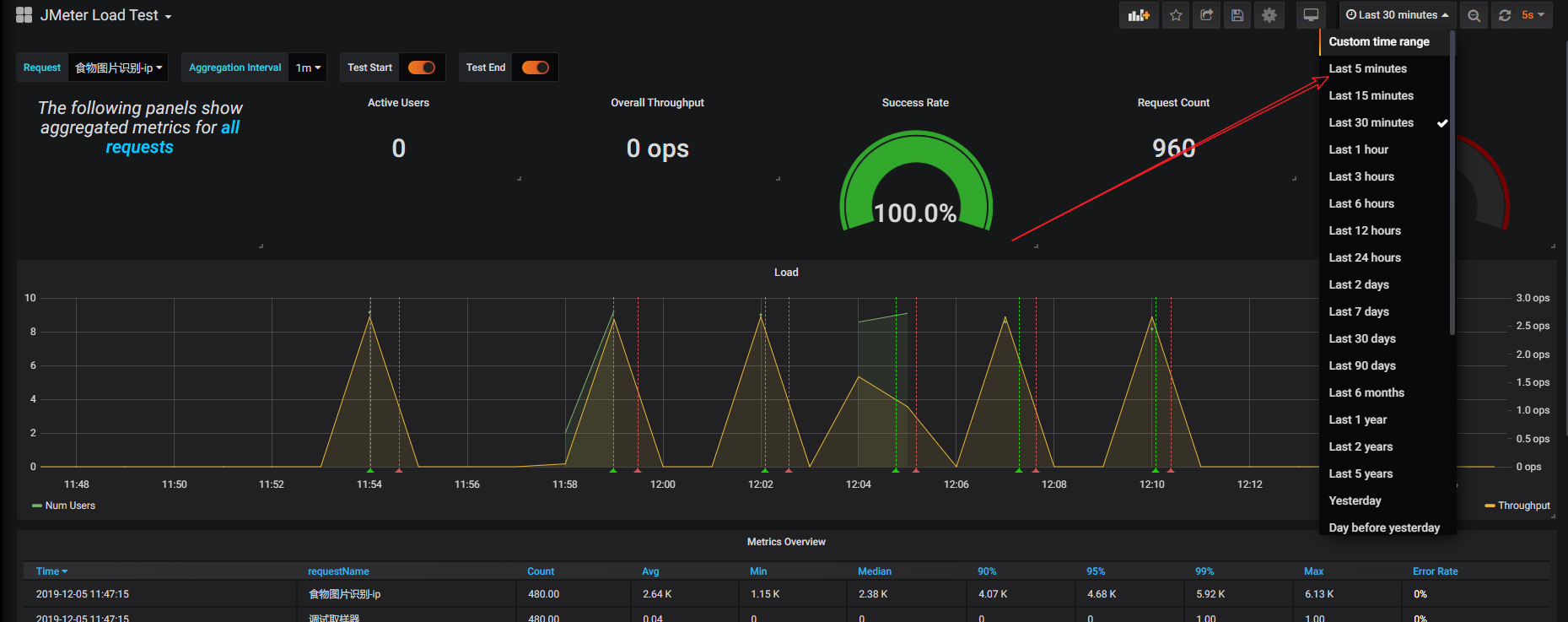
这里修改一下筛选条件即可~
Jmeter+ InfluxDB+Grafana安装配置的更多相关文章
- influxDB+grafana安装配置及邮件告警发送配置
1. InfluxDB安装 下载包并解压: $:wgethttps://dl.influxdata.com/influxdb/releases/influxdb-1.3.6_linux_amd64.t ...
- influxDB1.6版安装与配置(windows环境)、Jmeter+influxDB+Grafana性能监控
influxDB1.6版安装与配置(windows环境).Jmeter+influxDB+Grafana性能监控 来源:https://blog.csdn.net/SwTesting/article/ ...
- 性能工具之JMeter+InfluxDB+Grafana打造压测可视化实时监控【转】
概述 本文我们将介绍如何使用JMeter+InfluxDB+Grafana打造压测可视化实时监控. 引言 我们很多时候在使用JMeter做性能测试,我们很难及时察看压测过程中应用的性能状况,总是需要等 ...
- jmeter+influxdb+grafana性能测试监控
背景: 话说Jmeter原生的监控确实太丑了,听大佬们在讨论Jmeter+InfluxDb+Grafana的监控,于是,为了有一个漂亮的测试报告,就手动开始进行部署. 安装步骤: 1.influxdb ...
- 性能工具之JMeter+InfluxDB+Grafana打造压测可视化实时监控
一.安装配置InfluxDB InfluxDB是GO语言开发的一个开源分布式时序数据库,非常适合存储指标.事件.分析等数据.有人做过mysql和influxDB对比,存储1000万条数据mysql要7 ...
- 搭建jmeter+influxdb+grafana压测实时监控平台(超详细,小白适用)
1.前言 在使用jmeter做性能测试的时候,监控系统性能的时候,无论是使用插件还是报告生成,都没法实现实时监控.使用JMeter+Influxdb+Grafana可以实现实时监控. 本次环境搭建各软 ...
- grafana 安装配置
Grafana安装配置 1.下载安装包 wget https://s3-us-west-2.amazonaws.com/grafana-releases/release/grafana-5.1.3.l ...
- JMeter下载及安装配置完整版
特别需要注意的时,jdk版本和jmeter版本匹配问题. Jdk1.8对应apache-jmeter-3.3 Jmeter下载及安装配置 本文是在win7环境下安装使用jmeter,jmeter可以运 ...
- Prometheus(一):Prometheus+Grafana 安装配置
一.基础环境 系统 IP 监控主机 CentOS 7 192.168.56.200 被监控主机 CentOS 7 192.168.56.201 二.Prometheus服务端安装 以下操作皆在监控主机 ...
随机推荐
- Boosting Ensemble and GBDT Algorithm
Boosting Ensemble: 机器学习中,Ensemble model除了Bagging以外,更常用的是Boosting.与Bagging不同,Boosting中各个模型是串行的.其思想是,后 ...
- 【读书笔记】:MIT线性代数(1):Linear Combinations
1. Linear Combination Two linear operations of vectors: Linear combination: 2.Geometric Explaination ...
- Get column value of Flex Datagrid by QTP
' get the number of rows in the tablerowCount=Browser("Browser").FlexApplication("App ...
- Base64加密工具
正常来讲加密基本上永远都要伴随着解密,所谓的加密或者解密,往往都需要有一些规则,在JDK1.8开始,提供有新的加密处理操作类,Base64处理类--Base64类 在该类之中存在两个内部类:Base6 ...
- C++中的静态成员函数
1,问完成的需求: 1,统计在程序运行期间某个类的对象数目: 1,静态成员变量满足了这个需求: 2,保证程序的安全性(不能使用全局变量): 3,随时可以获取当前对象的数目: 1,有没有什么特别的地方或 ...
- 多线性方程组迭代算法——Gauss-Seidel迭代算法的Python实现
多线性方程组(张量)迭代算法的原理请看这里:原理部分请留言,不方便公开分享 Jacobi迭代算法里有详细注释:多线性方程组迭代算法——Jacobi迭代算法的Python实现 import numpy ...
- 搭建 webpack、react 开发环境(三)
配置 react-router-dom 我们开发一个 React 工程肯定不是一两个“页面”就可以满足需求的,所以我们需要一个在多个“页面”中跳转的功能,在使用 React 构建的单页面应用中,要 ...
- UVALive 4728 Squares(旋转卡壳)
Squares The famous Korean IT company plans to make a digital map of the Earth with help of wireless ...
- java虚拟机规范(se8)——class文件格式(七)
4.7.5 Exceptions 属性 Exceptions 属性是一个变长属性,它位于 method_info(§4.6)结构的属性表中. Exceptions 属性指出了一个方法需要检查的可能抛出 ...
- 【记录】Redis 基础
Redis可以存放五种类型 1:String(字符串) 2:List(列表) 3:Hash(字典) 4:Set(集合) 5:ZSet(有序集合) String (字符串) redis 127.0.0. ...
